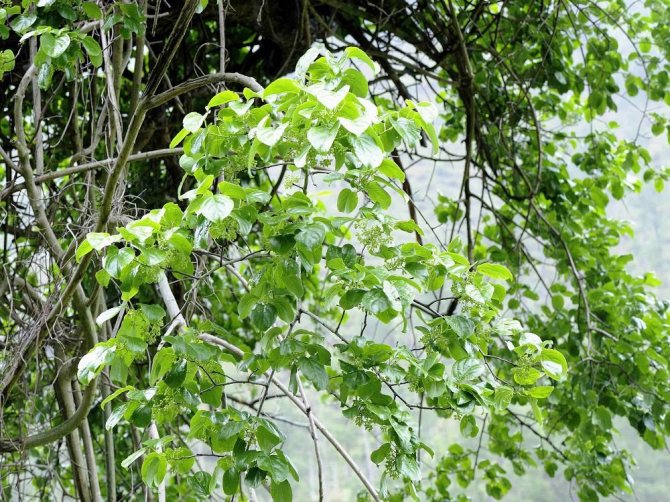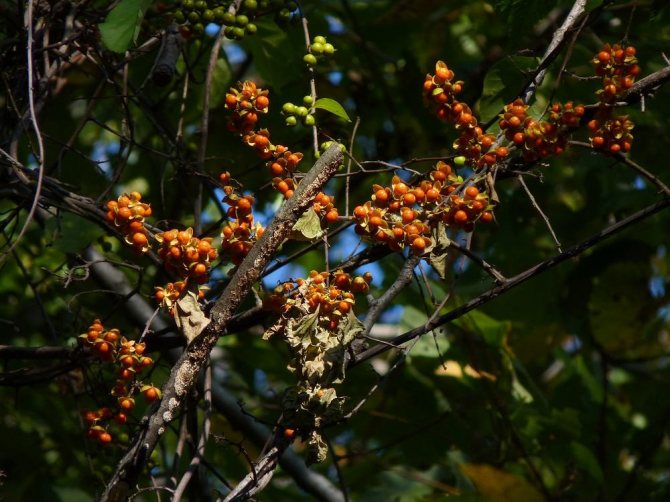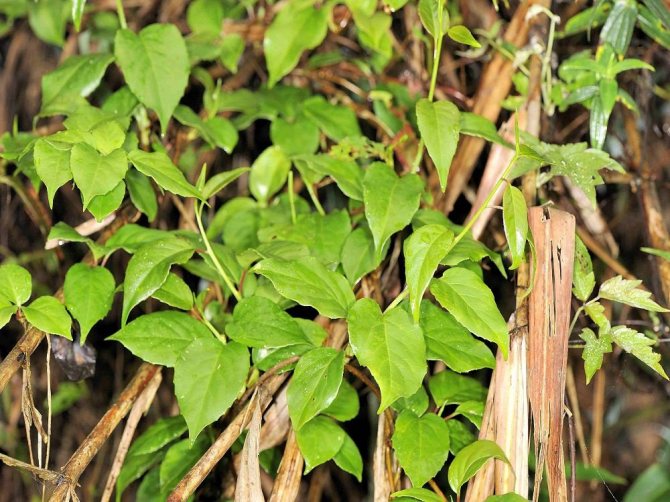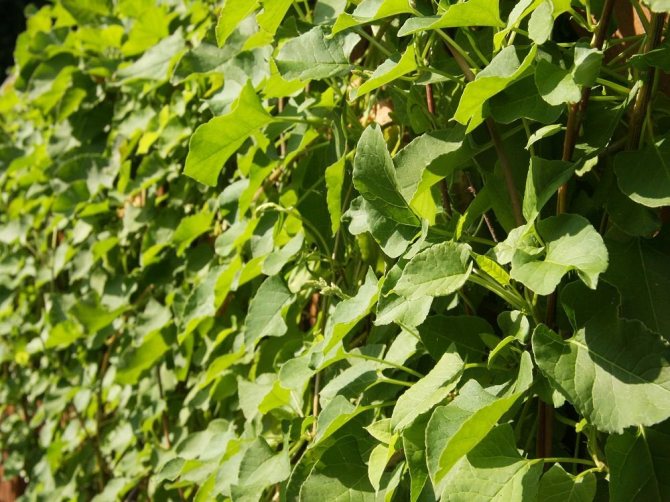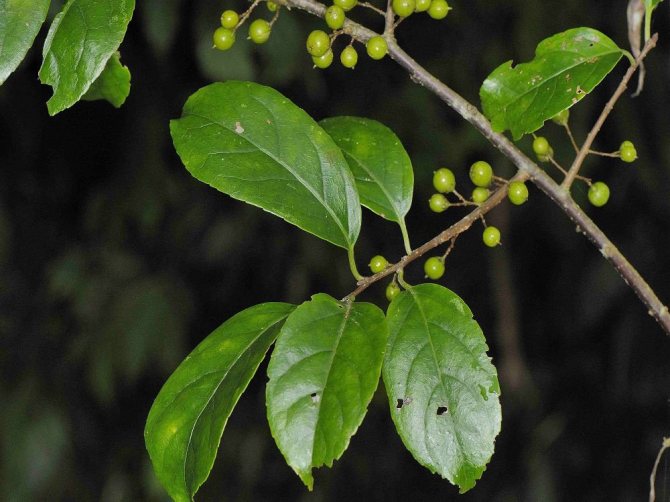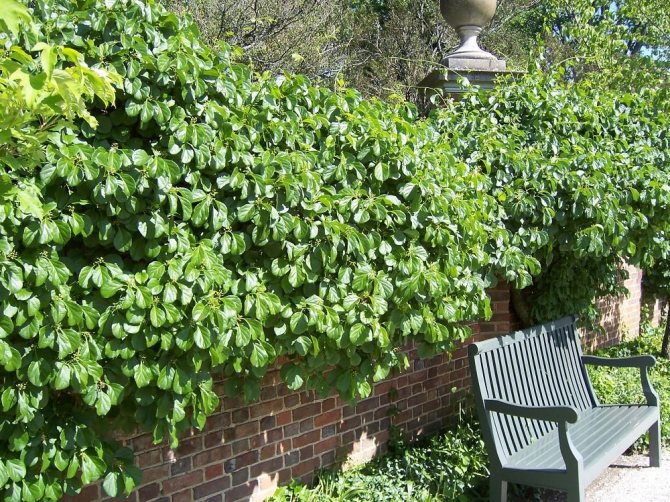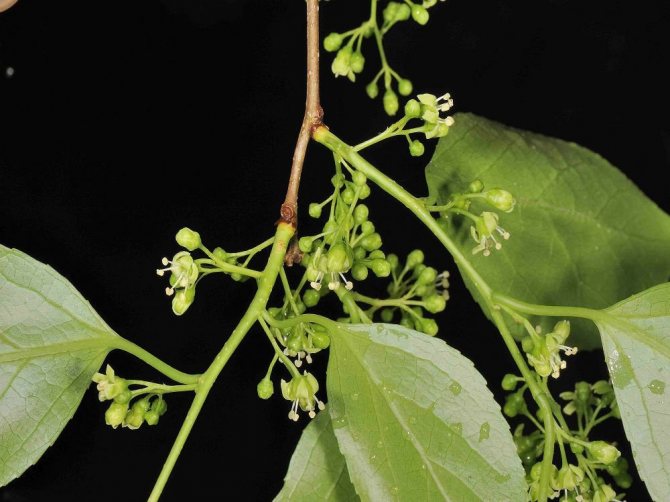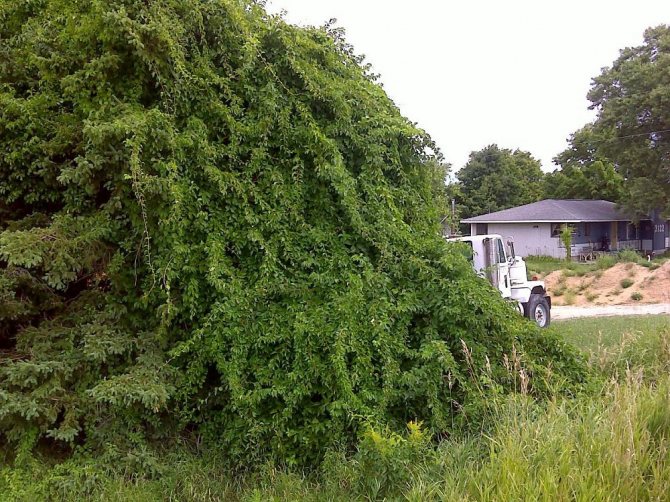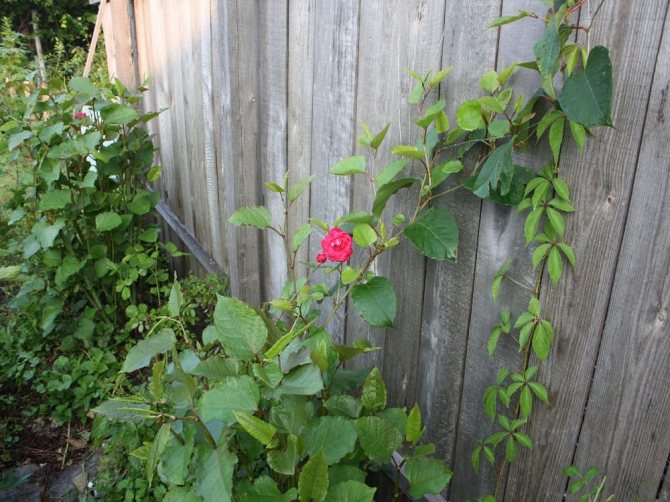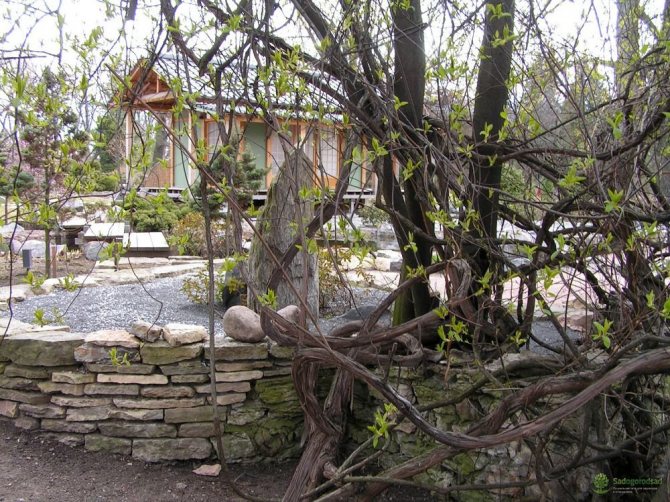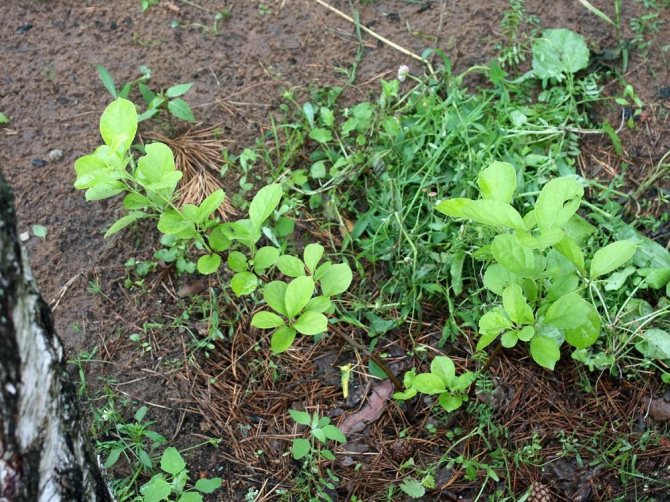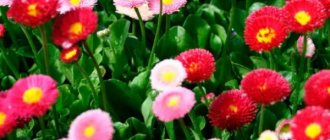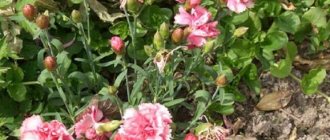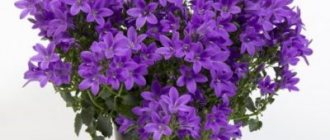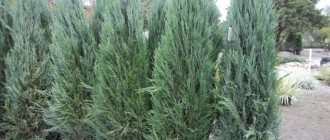Woodlip is a perennial ligneous vine from the Euonymus family. In its natural environment, it can be found in subtropical and tropical forests around the globe. The plant got its name for its aggressive, parasitic behavior towards other large trees. Braiding them, the vine grows deep into the wood and gradually drinks all the juices of the donor plant. The trunk of a dry tree continues to serve as a reliable support for the woodworm. In landscaping, the plant is great for decorating fences and gazebos. But it should be kept away from fruit trees. It is valued for its abundant green mass, which in autumn acquires a delicate golden color, as well as for its orange-red fruits.
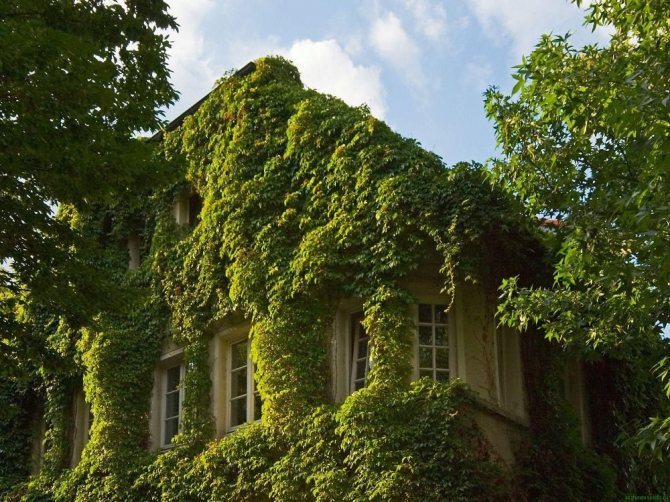
Botanical description
Woodworm (lat.Celastrus) is a fast-growing deciduous (less often evergreen) liana of the euonymus family. Powerful woody shoots up to 10 cm thick and about 50 m long climb on a vertical support to a height of up to 12 m. The annual growth is about 1 m. Shrub forms are found.
Stems are sparsely leafy, but numerous short shoots are densely covered with leaves. On the stems there is a dark bark with deep longitudinal cracks, young shoots are covered with a thin bark - at first it is green, over time it acquires an orange-red or brownish-brown hue.
The leaf plates are dense, obovate with a pointed tip, the length and width are 5-10 cm, the color is bright green (the leaves turn yellow in autumn).
If there is a support, the liana climbs it, a wide (about 3 m in diameter) branched crown forms at the top. Without support, the shoots will travel freely along the ground, creating dense thickets.
Popular varieties
The genus of woodworm has 38 species, of which only 3 grow on the territory of Russia. Mostly in the Far East.
Round-leaved woodworm. The plant is found in China, Japan and the Far East. This large, climbing liana grows up to 2.5 m in culture. In nature, vines up to 12 m long can be found. Lateral shoots, densely covered with foliage, form wide thickets. Strong ligneous processes are covered with brown-brown bark. Younger shoots have glossy dark green leaves. Rounded or oval leaf plates are pointed at the end. Below the leaves have a bluish dusting. During the flowering period, numerous paniculate inflorescences are formed in the leaf axils, and in September, orange-yellow fruits in the form of rounded berries ripen. The diameter of the fruit does not exceed 6 mm. Bright clusters persist on the branches even in winter and look beautiful among the snowdrifts. The popular Punctata cultivar has more modest shoot and leaf sizes. There are white dots on the bright green leaf plate.
The round-leaved woodworm is a dioecious plant. That is, there are specimens exclusively with female (Diana variety) and male (Hercules variety) flowers. The listed decorative varieties are distinguished by abundant flowering and fruiting, as well as a dense dark green crown.
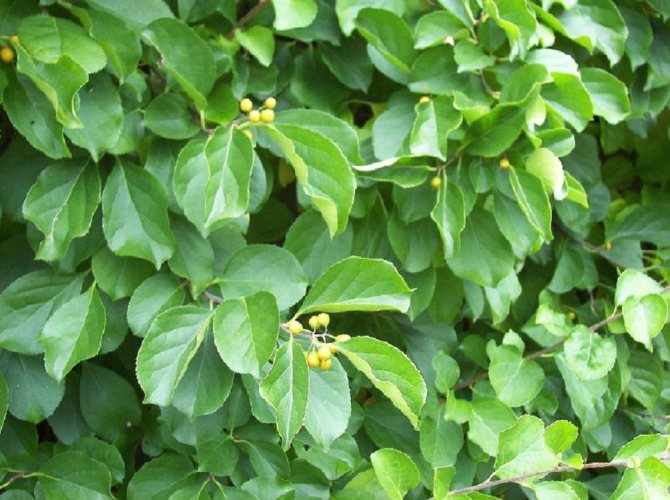

Round-leaved woodworm
Climbing tree plier. The length of this woody deciduous liana is 8-12 m. The bark of young shoots is colored red-brown, but gradually becomes brown-brown in color.The stems are dotted with alternate ovoid leaves 4-8 cm long. In July, paniculate inflorescences appear on the plant, which consist of small yellow-white flowers. Rounded seed pods appear in August-September. Bright red berries with a diameter of 4-6 mm are hidden under the yellow stipules.
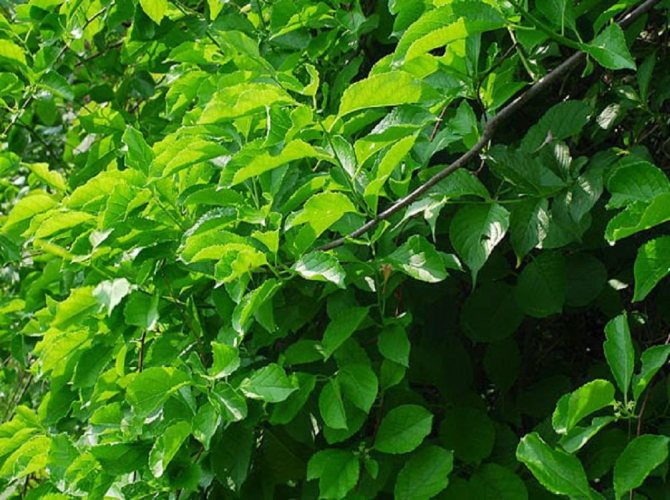

Climbing tree plier
The woodworm is brush-shaped. Scourges up to 12 m long are covered with brown-brown bark with small scales. On the young parts of the shoot, oval or ovoid leaves are located, which reach a length of 14 cm. Bright green wrinkled leaf plates are dotted with many small veins. At the end of June, bunches of green-yellow flowers are formed in the axils of the leaves, and by September, rounded seed pods with a diameter of about 7 mm ripen.
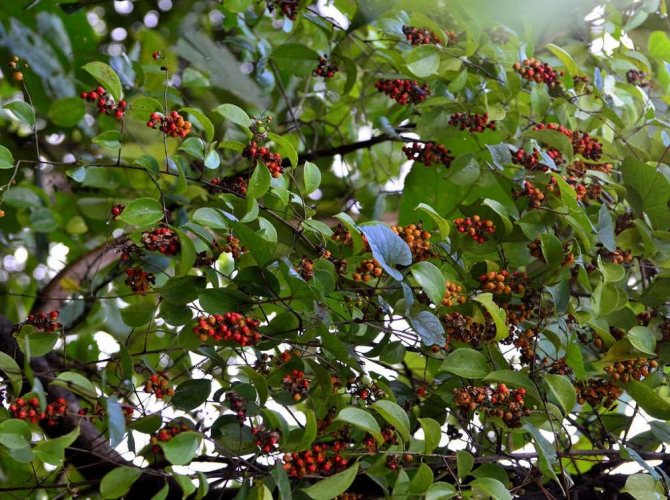

Brush-nose plier
Where is common
The genus has about 30 species. In the natural environment, they are common in America, Australia, and the Far East. The woodworm can be found in mixed forests, bushes, along steep banks of rivers and reservoirs.
Woodmouth - The name sounds a little intimidating. A plant is really capable of destroying a tree: the stems twine around the trunk, bite into it with hooks, over time the tree dies. Therefore, it is important to find the right planting site on the site. Liana is tenacious, unpretentious in care, used to decorate fences, gazebos, verandas.
Photo gallery of views
When the woodworm blooms and bears fruit
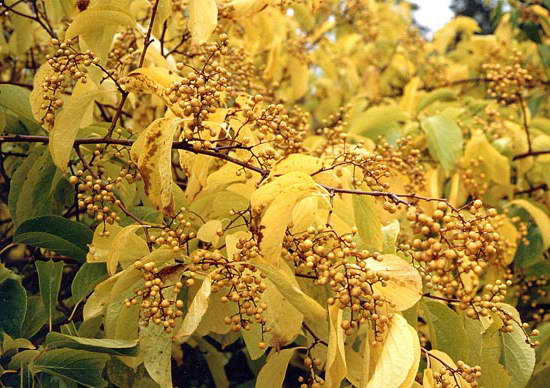

Angular beard Maxim Celastrus angulatus Maxim photo
During flowering, which starts in June-July, fragrant panicles bloom. The flowers are not particularly decorative: small, greenish. The fruits give a special charm to the liana: the plant is strewn with greenish balls, as they ripen, they open. Against the background of still green leaves, red berries with dry yellowish stipules flaunt. They stay on the plant almost all winter and are inedible. Due to the appearance of fruiting, the people call the plant a red bubble. Flowering occurs around the 5th year of growth.
Please note that only female vines bear fruit. In order to enjoy the bright colors of the fruits in autumn, both a female and a male plant must be present on the site for pollination.
Decorative use
Redbubble is grown for vertical gardening; ground cover species are also known, for example, D. whip-like, which is also good for decorating the banks of reservoirs. D. round-leaved is prized for its round and shiny leaves and beautiful, bright fruits. It is used to decorate slopes. D. Curly is good for decorating walls and high fences.
Any type can be used for landscaping and decorating unsightly walls, for creating shaded gazebos, they are also good for creating hedges. Plants are popular for large beautiful leaves, rapid development, bright berries. Celastrus is decorative at any time of the year, which is also used in landscape design. The red bubble is very beautiful on stone fences.
Growing woodworm from seeds
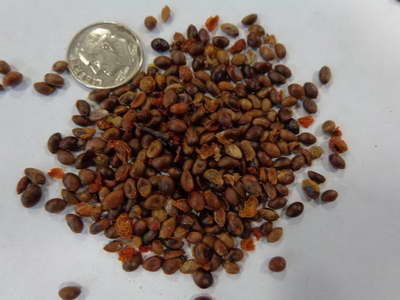

Seeds of woodworm photo
Seeds are sown directly into open ground before winter or spring.
Sowing in winter is easier: freshly harvested seeds are freed from seedlings, dried for 3 weeks and sown. The seeds will undergo a natural stratification process and will sprout in the spring.
When sowing in the spring (around April), pre-treatment of the seeds is required. There are two ways:
- For 2-3 months, the seeds are kept at a temperature of 0 to +3 ° C (the vegetable section of the refrigerator is perfect for this).
- Mix seeds with wet sand 1 month before sowing and keep at a temperature of 18-23 ° C.
Dig up the area, sow seeds in holes, water, you need shelter for the winter. Seedlings appear in about 1 month.
Where did this strange plant name come from?
The deciduous liana received such a terrifying name for the ability of its sickle-shaped hooks to grow into the trunk or branches of a tree, braid them and literally choke the plants with its embraces until they die. Therefore, it is not recommended to plant round-leaved wood pliers near valuable garden trees, such as:
- Apple tree.
- Pear.
- Plum.
- Apricot, etc.
[collapse]
Vegetative reproduction of woodworm
Cuttings:
- Best of all, the plant propagates by cuttings from green shoots.
I cut them in the spring. The length of the cutting should be (about 7 cm). Treat with growth stimulants, root in a sand-peat mixture (the stalk is placed vertically), cover with a glass jar or a cut plastic bottle on top. The roots will appear in about 1.5 months.
- Cuttings from woody shoots are cut in the fall.
This method is less productive. For the winter, a container with cuttings is sent to a cool room (for example, a basement). The roots will appear by about June - transplant into open ground in the fall.
- Root cuttings are cut in the spring.
They should be about 7 cm long and have buds of growth. Submerge completely in the soil, placing it horizontally. The roots will appear in about a month.
You can propagate the vine by layering. To do this, in the spring, bend the shoot to the ground, fix it with a bracket, make a shallow incision, sprinkle it with earth on top, water it well. After a few months, a shoot will appear, it is better to separate it from the mother plant in the spring.
Liana gives a large number of basal processes - carefully dig them up and transplant.
Maiden grapes
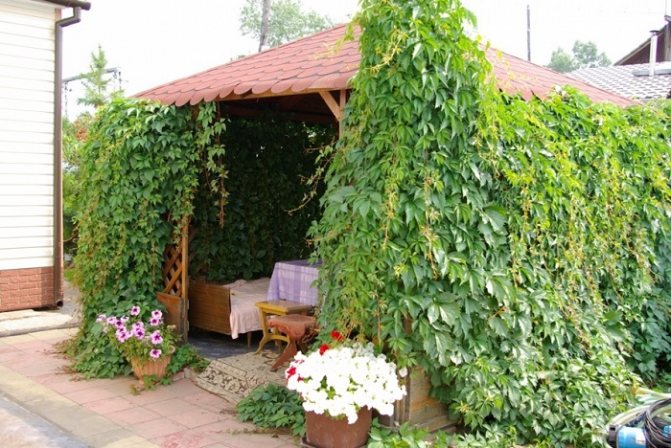

It can grow very quickly. Sometimes during one growing season, vines grow up to three meters, creating a dense green curtain.
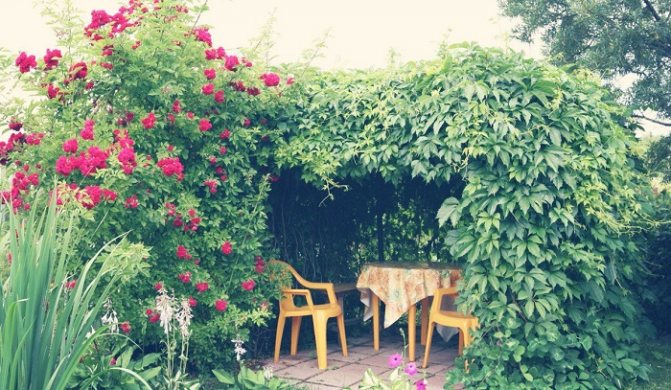

A few years after planting, you will have to prune the shoots, they develop so rapidly. Root shoots will also not keep you waiting long, therefore, if there is not enough time to deal with it, it is better to immediately fence off the bushes with curb tape.
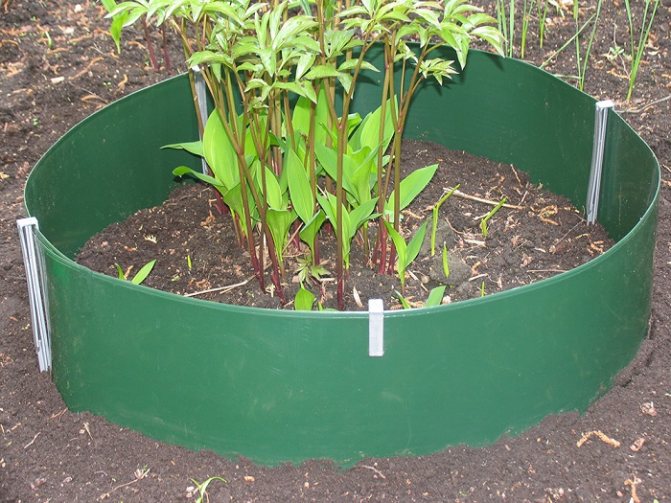

It is recommended to plant maiden grapes on the sunny side. Only in this case, in the fall, the foliage acquires a bright burgundy color.
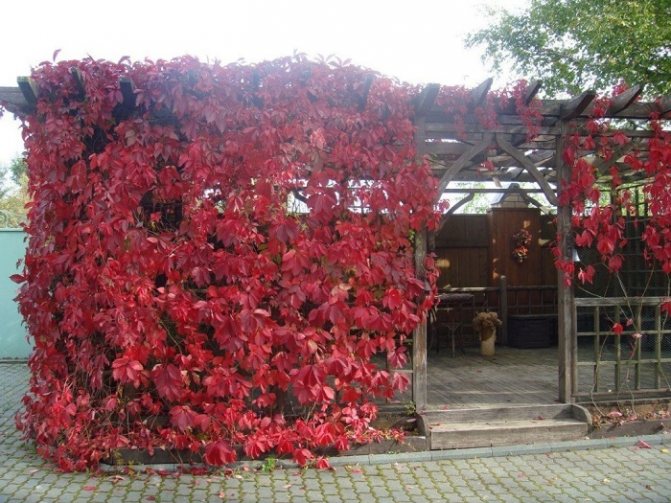

If you plant it interspersed with the round-leaved woodworm, in autumn you can admire the incredible combination of burgundy and yellow colors.
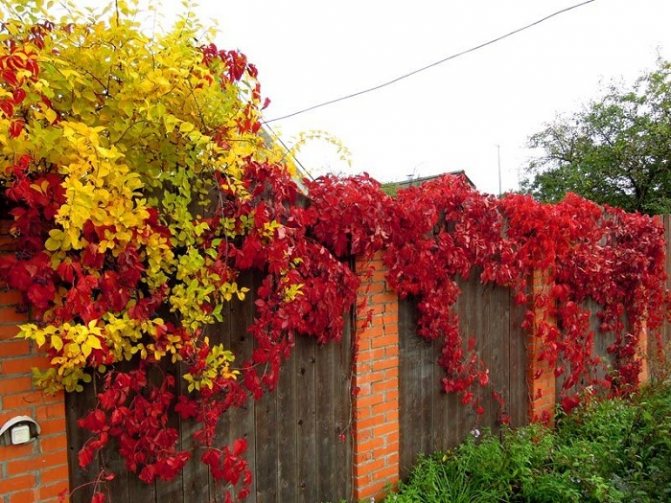

Advice! The dark blue small fruits of the maiden grape are not edible. If the garden area is small, it is better to plant the gazebo with table grapes, which will create shade and produce delicious berries.
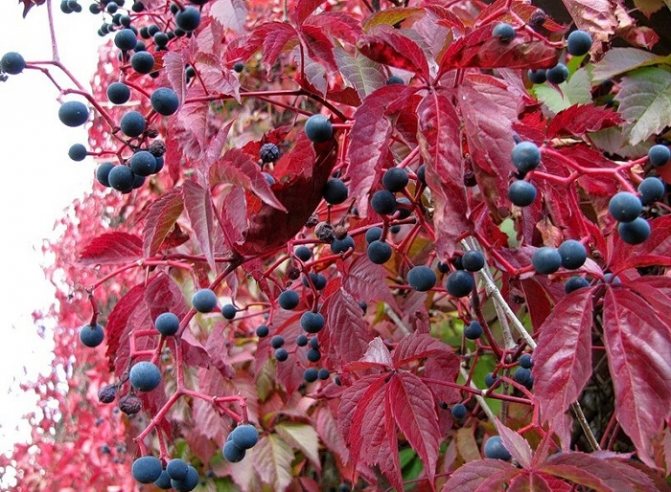

Maiden grape fruit
Choosing a site for planting a red bubble
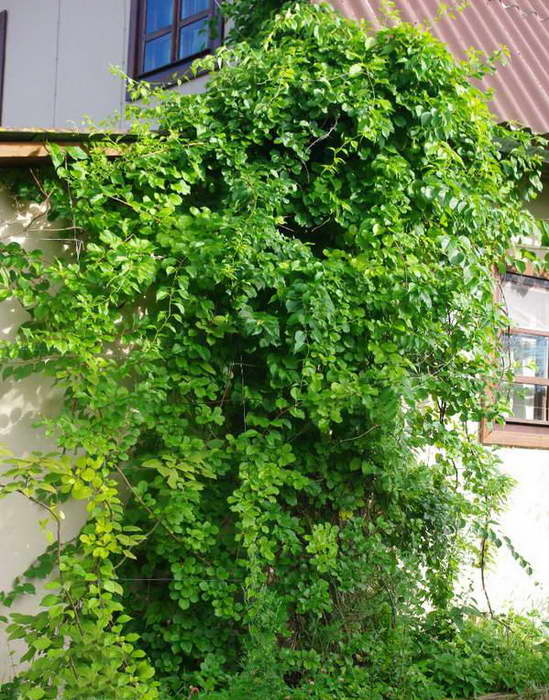

Round-leaved woodworm Hercules Celastrus orbiculatus photo
Liana grows equally well in an open sunny area and in shade.
Any soil is suitable for growing, but the plant will develop better in fertile, loose soil.
Previously (about 1 month before planting) for digging, add humus, leafy soil and a little sand for drainage.
The main characteristics of creepers
As mentioned above, the Woodlonger is a woody vine and is a fairly large species. Some varieties belong to shrubs and may even be evergreen. In the wild, climbing liana is found in mixed forests, on steep banks of water bodies and rivers on almost all continents. Some might have heard of such a plant as the Red Bubble, which is the popular name for the same Tree-nose.
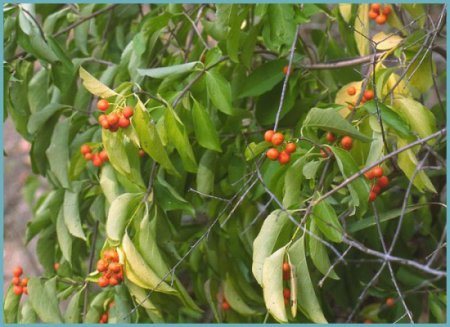

How to plant a woodcutter in the garden
Planting seedlings in open ground can be carried out both in spring and autumn. Saplings 2-3 years old have the highest survival rate. Dig the planting holes 30 x 30 cm, the depth is about 10 cm more than the root system for laying drainage. Place the seedling in the planting hole, straighten the roots, cover half of it with soil, water, add soil, squeeze your palms around the trunk. When planting, you can slightly deepen the root collar.Cover the soil surface with sawdust or peat (layer thickness about 7 cm). A distance of 80-100 cm is kept between individual plants.
A plant is planted along buildings, hedges, or a special support is created.
Growing
Location... Redbird tolerates shading well, but develops better in illuminated areas. Strong supports are imperative. These can be gazebo props, fences, large trunks of old dead trees.
Soil and planting... The woodworm is undemanding to the composition of the earth, but prefers rich soils. Fertilizing is optional. It is possible to feed with organic matter once a season (in spring). For planting, use 2-3 year old seedlings. The root collar is not buried; the hole fits 50 by 50 and 60 cm deep. The soil around young specimens is mulched with peat or sawdust (5-10 cm). A transplant is possible in the spring.
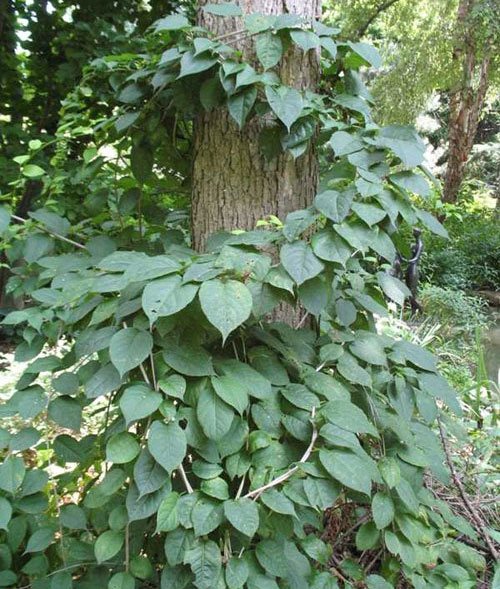

The wood-nose pliers need strong support
Care... Plants are frost-resistant, even creeping species. The woodworm loves moist soils, so it requires regular watering, once a week. Celastruses are unpretentious, do not get sick and do not suffer from temperature extremes and frosts. It is useful to loosen the soil around the trunks.
Pruning... Formative pruning of red bubble is carried out in early spring, dry and excess shoots are removed to thin the crown. The woodworm tolerates pruning well, shoots grow quickly. If breeding is not planned, the root growth is removed. With too active growth in the summer, you can slightly cut the "knocked out" shoots.
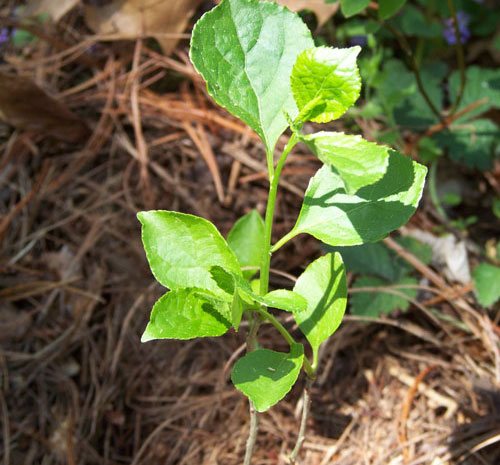

Woodworm sapling
Caring for the woodworm
The woodworm is drought tolerant. Adult plants are content with precipitation, in the summer they are shed about 1 time per month, adding 15-20 liters of water to each plant. Young plants are shed a little more often for successful rooting.
After watering, loosen the soil well in the trunk circle.
In early spring (before the start of sap flow), sanitary pruning is carried out: remove damaged, frozen and weak shoots. During the growing season, light formative pruning is carried out: the crown is thinned out, shoots that are knocked out of the general view are removed. Be careful: all parts of the plant are poisonous, avoid getting the juice of the plant on the skin and mucous membranes.
It is enough to feed the redbubble 2-3 times a season. In the spring and summer, place the granules of the complex mineral fertilizer in the circle near the trunk, embed them to a depth of about 15 cm, water. In the fall, apply the phosphate-potassium dressing in the same way.
Description
The woodworm is a deciduous vine with two types of shoots: curly and straight. Some species are evergreen. Curly shoots are long and not very leafy. Erect, on the contrary, short with a lot of foliage. Flowers are dioecious, small and inconspicuous, grouped in corymbose or paniculate inflorescences. The color of the corollas is white, greenish or pink. The leaves are simple, arranged alternately, the shape of the plate is ovoid, 5-20 cm long. The fruit is a rounded box with three opening valves, inside which there is a fleshy berry, colored red or yellow, containing seeds. The fruits of the red bubble are eaten by birds, thus spreading the seeds. Flowering occurs in June, the fruits ripen by September.
Attention: all parts of the plant are poisonous to humans if ingested!
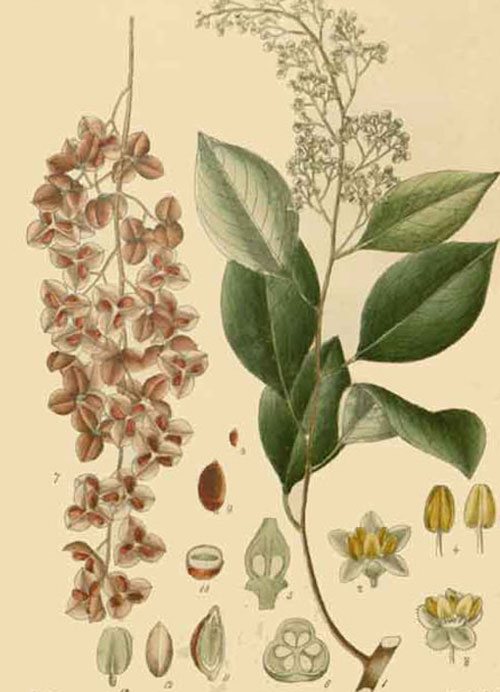

Botanical illustration
Types and varieties of woodworm plant
Climbing or curly woodworm, American Celastrus scandens
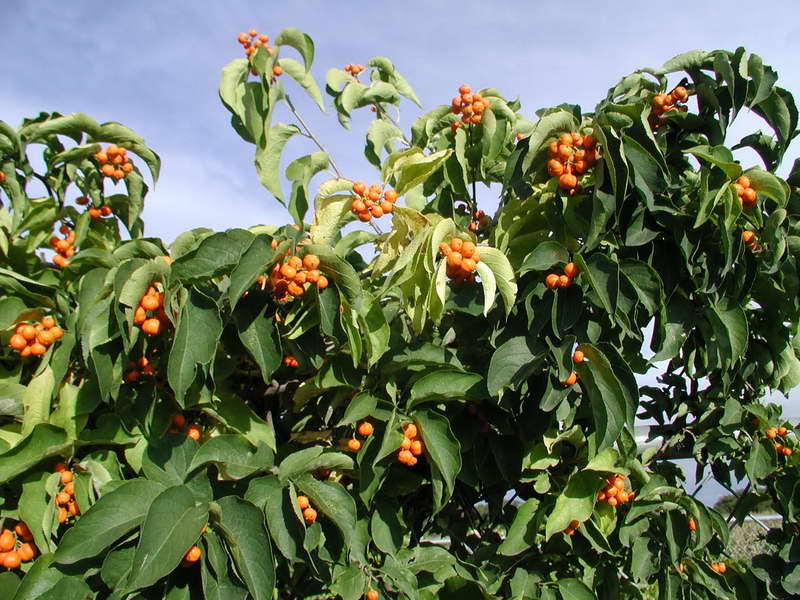

Woodworm climbing or curly, American Celastrus scandens photo
The most popular species in horticulture, often grown unsupported in a creeping form. The wicker liana reaches a length of 10-12 m. The leaf plates are rounded at the base, the tops are pointed, the light green color changes to yellow in autumn. Flowering begins in June and lasts about 25 days, flowers are small, yellowish.The greenish spherical fruits ripen to red by October.
Round-leaved woodworm Celastrus orbiculatus
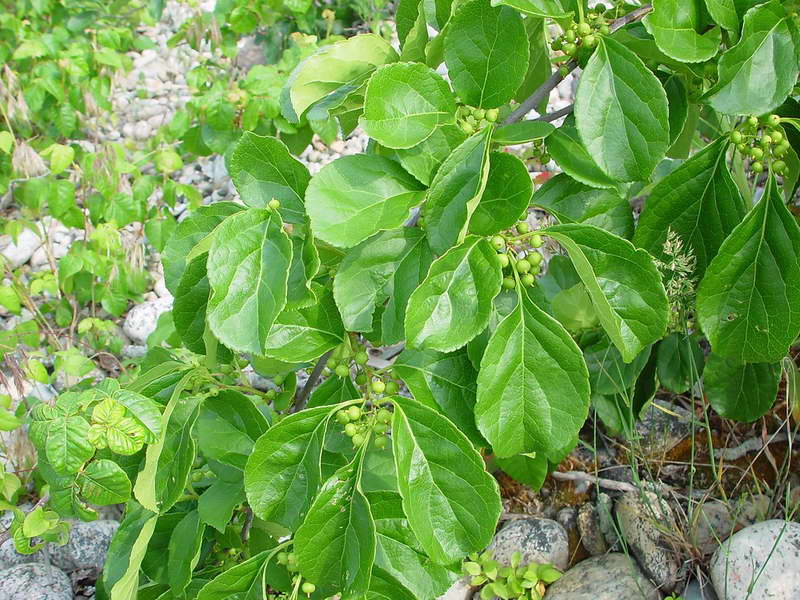

Round-leaved woodworm Celastrus orbiculatus photo
The length of the liana reaches 18 m. The leaf plates are inversely ovoid, the surface is glossy, dark green in color, from below they are rough, with a bluish tinge. Inflorescences are similar to the previous type, unripe fruits have a yellowish tint.
Varieties:
- Diana is a female decorative form.
- Hercules is a male decorative form, does not bear fruit.
Whiplash or whiplash Celastrus flagellaris
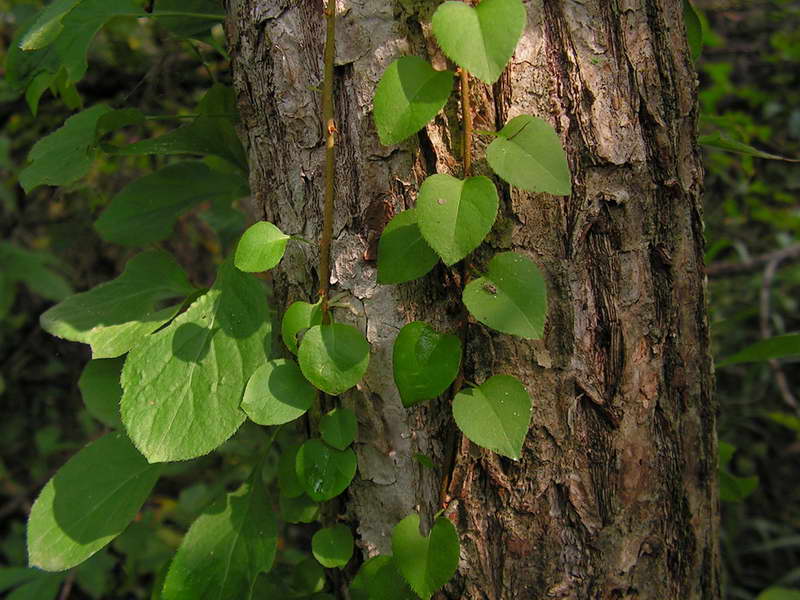

Lash-nose or lash-like Celastrus flagellaris photo
Used as a ground cover plant, it grows well in the northern regions. The lashes are stretched in length by about 10 m. The leaf plates are ovoid with serrated edges.
Bristle-nose pliers Celastrus strigillosus
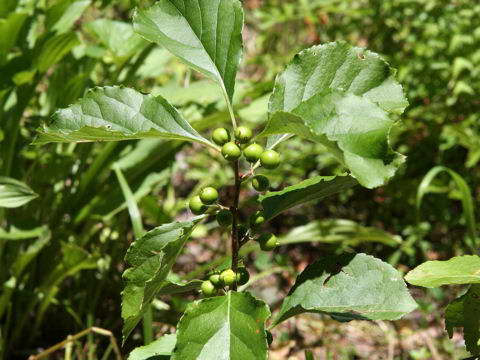

Corymbose plier Celastrus orbiculatus var. strigillosus photo
The length of the vine is limited to 12 m, the crown diameter is about 6 m. The trunk is covered with scaly bark of a dark brown hue. Leaf plates about 14 cm long, sinewy, bright green.
Woodworm Celastrus angulatus
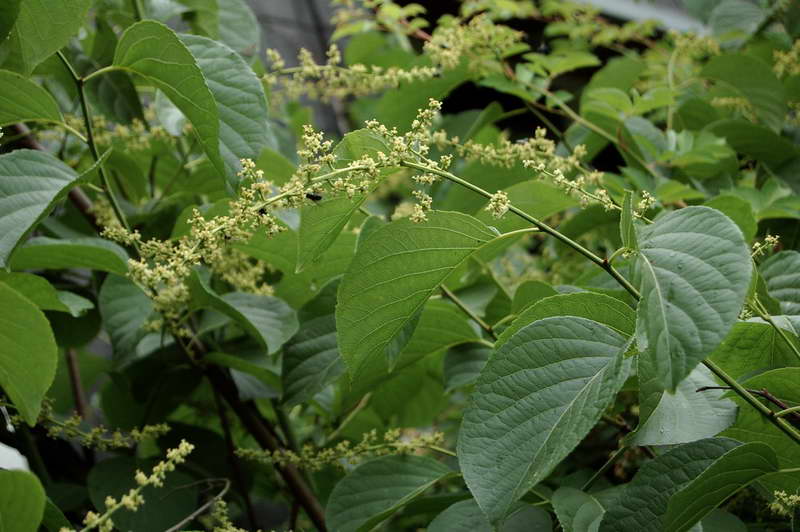

Angular beetle Celastrus angulatus photo
In the presence of support, it climbs to a height of 7 m or spreads out with a shrub to a width of 6 m. It has very large leaf plates: 18 cm long and up to 14 cm wide, the shape is broadly elliptical. It blooms in May, and in September the boxes open.
Woodlip bottom white Celastrus hypoleuca
The length of the lashes reaches 5 m. Young shoots are slightly pubescent, with a red-brown bark. Elliptical leaf plates (about 15 cm long and up to 5 cm wide), the surface is smooth, dark green, the reverse side is whitish with a bluish tint.
Paniculata Celastrus paniculatus
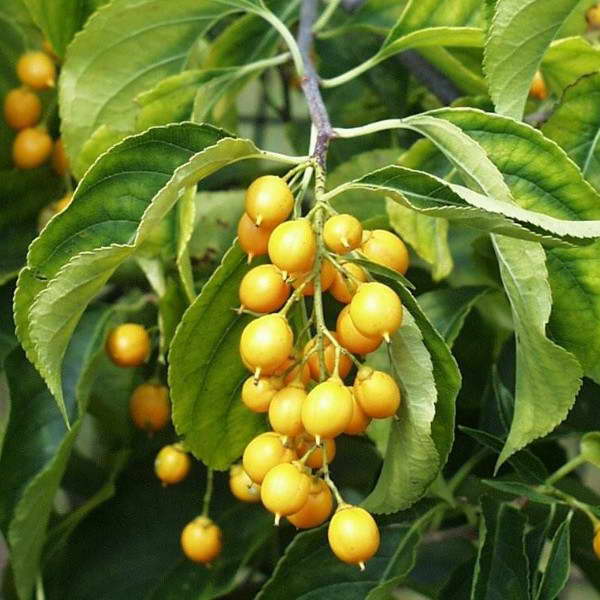

Paniculata woodworm Celastrus paniculatus photo
The plant reaches a height of 6 m. Leaves are oval. From the seeds of this type of woodworm, oil is made, which is used in Ayurveda.
Wrinkled woodworm Celastrus rugosa
In the conditions of the middle liana, the liana grows up to 4 m long.
Round-leaved woodworm
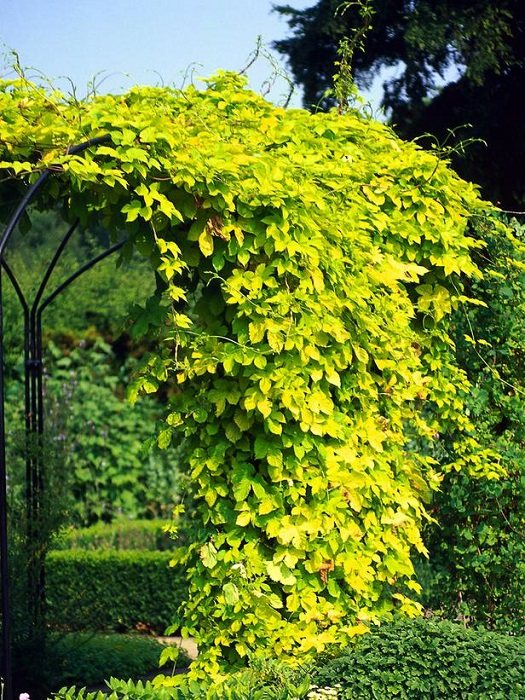

The growth rate and high winter hardiness make this type of tree-like liana very attractive for landscaping the walls of arbors and creating green arches. It grows up to 7 meters in length and blooms in May for about one and a half weeks.
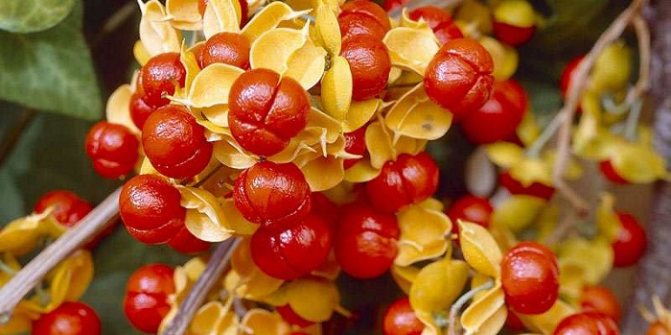

Woodworm berries
In autumn, orange-red berries look very impressive against the background of yellow foliage. The name "Wood-nose" is fully consistent with the properties of the plant: you should not plant a liana next to fruit trees, since it twists around the trunk so tightly that it destroys the plant.
Important! The fruit of the round-leaved woodworm is poisonous but can be easily prevented by planting only male or only female plants.
Woodcutter Uses
The plant is widely used in and has great potential in this direction. In summer, liana is a wonderful background for a flower garden and pleases with its green leaves. In the autumn period, the woodworm is replete with bright colors. In winter, branches with beautiful seeds are often used to compose various compositions, bouquets, ikebans. Very often, the round-leaved wood plier Hercules is used for It perfectly decorates nondescript buildings, as well as:
- Fencing.
- Gazebos.
- Arches, etc.
The tree liana is very often used as a cover for soils on slopes, embankments and Preparations from seeds, roots, leaves and shoots of woodworm are used in Chinese traditional medicine to treat various diseases.
Diana climbing tree - photo
Description of the plant
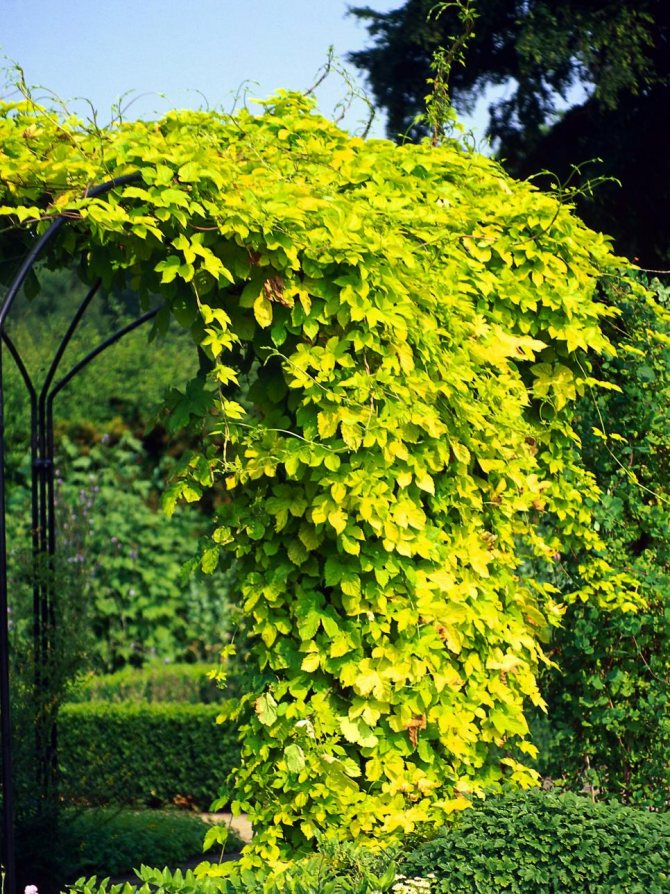

The woodworm belongs to the Bereskletov family, has about 30 species, is a perennial liana-like plant.
The woodworm belongs to the Bereskletov family, has about 30 species, is a perennial liana-like plant.
In nature, the stalk of the woodworm reaches 10 - 14 m.In culture, the stem of the shortest liana, no more than 7 m, belongs to the USA or American woodworm.
The stem of young shoots is green, smooth; over time, the trunk thickens, coarsens, cracks, darkens, acquires a gray-brown color.
Leaves are simple, rounded, no more than 8 cm in length, arranged in turn. Some species have dense foliage, others are less deciduous. Depending on the season, the color of the leaves changes: in spring - green, dark green, in autumn - the color varies in different shades of yellow. The plant is deciduous, sheds foliage with the first frost.
The flowers are fragrant, small, inconspicuous, pale yellow, collected in paniculate inflorescences near leaf cuttings. The period of blooming flowers is June - July, the duration of flowering is no more than seven days.
The ability to produce flowers appears in a plant from the age of five. The tree-nose is a heterosexual plant, for example, the Diana variety has female flowers, and the round-leaved Hercules variety has male flowers.
During the period of leaf fall, instead of flowers, seeds are formed that look like a ball covered with thin husks. At the time of ripening, the shell cracks into three valves, inside there is a bright red seed-bearing round. Unpretentious to the soil.
Photophilous, but also able to develop in the shade. For this quality is actively used in landscape design. The use of wood pliers is gaining popularity in the Moscow region when decorating the facades of houses and various buildings.
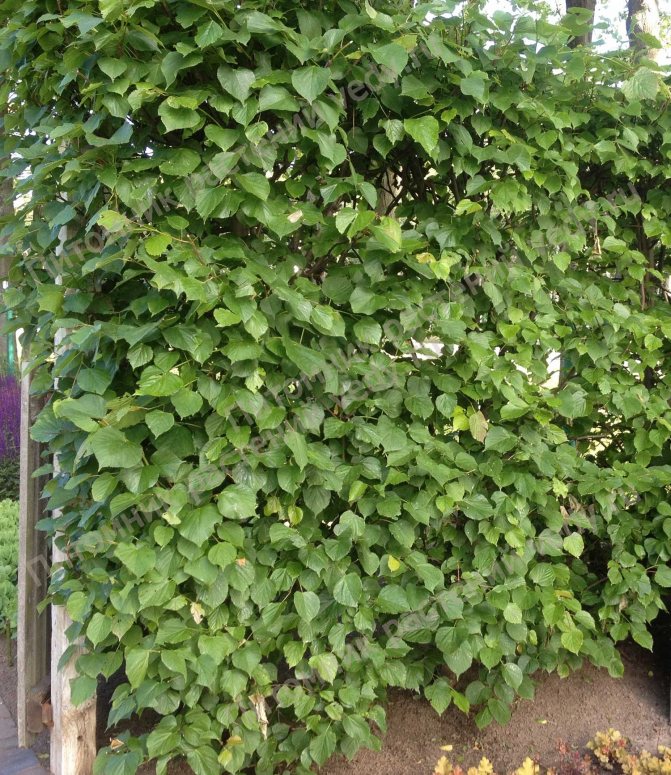

Reproduction methods
Adult plants are obtained in two ways:
- root cuttings.
- from seeds;
For planting by the first method, you will need to purchase it in a store in the fall, ask neighbors or cut cuttings of roots from your Dianes, 70-100 mm long and at least 5 mm in diameter. A trench is carefully dug next to the mother bush. Well-developed roots are cut off from the main one, placed in boxes, covered with sand and stored in this form throughout the winter in the cellar.
In the spring, for better development of the bush, cuttings are pre-soaked (15-16 hours before planting) in a growth stimulator, experienced gardeners recommend 0.01% Heteroauxin solution. In the place reserved for the vine, a trench is dug, and shoots are planted in it, in the order they will develop in the future. If you are not sure that the cuttings will be accepted, plant 2-3 shoots in 1 hole, then choose the strongest, and transplant the rest to another place or discard.
If the cuttings were in the school, the grown liana is moved to a prepared place after 2 years. Such a bush will bloom for 4-5 years.
How to plant a woodcutter
It is better to choose well-lit places for planting the woodworm, although the vine feels good in partial shade. Prepare the soil - a mixture of equal parts of humus and leafy or sod land. Liana grows well on sandy, loamy, loose fertile soils.
You can propagate by seeds, root cuttings. Seeds are sown in autumn, immediately after ripening and collection, or in spring, in April. After harvesting, the seeds should be allowed to ripen for 3 weeks and dried. Before spring sowing, the seeds are kept at room temperature in wet sand for a month.
In May, seedlings appear and grow rapidly, growing by 80 cm by autumn. For the first 3 years, young lianas freeze slightly, so they are covered. Then the seedlings become frost-resistant. At the age of 7, the vine begins to bloom.
Propagation by root cuttings is carried out in the spring, for which the roots are cut into 7 cm pieces and planted obliquely, completely immersed in the soil. After a month, roots and shoots are formed. Cuttings can also be made from green or lignified shoots. Lignified cuttings are cut in the fall so that there are 4-8 buds on the segment, planted in boxes. Roots are formed by June.
The plant, according to the site, is best planted at a distance of 1 meter. The largest survival rate is in 2-3-year-old seedlings.For older plants, a support up to 12 m high is needed. The planting hole is made 50x50x60 cm, drainage from crushed stone, broken brick, sand is placed on the bottom. It is best to replant plants in spring and fall.
Procurement of raw materials for woodworm Diana
If a large-leaved Diana variety grows on your site, then you can try to prepare raw materials that can be used for medicinal or other purposes.
- In order to collect the seeds of the woodworm Diana, you need to wait for the fruit of the vine to ripen. After they ripen, they are removed from the branches and dried in the sun for 1-2 days. Then you need to extract the seeds from the fruits. The seeds also need to be dried well in a ventilated place for 8-10 days. The seeds are then put into plastic containers and stored for up to 1 year.
- In order to prepare the leaves or shoots of the woodworm, you need not to miss the moment when these parts of the plant are full of juice - from April to October. Parts of the plant are dried for 2-3 weeks in the shade of trees or under a canopy, then crushed and packed in textile or paper bags for storage. The recommended storage time for such raw materials is 1.5 years.
Diana woodcutter - will become a real decoration of your garden, if you know about all the intricacies of its planting. In the summer you will admire the lush green foliage, in the fall you will observe the yellowing of the leaves and the formation of fruits, and practically throughout the winter, the tree-nose will catch the eye with bright red fruits on bare shoots.
What is red bubble
The most popular can be called the American Woodlip, which is a deciduous shrub that is distinguished by its rapid growth and excellent decorative characteristics. Liana has very powerful smooth shoots, on which are petiolate leaves of a light green color. In the autumn, the leaves change their color to yellow and completely fall off by winter. The plant blooms with white flowers with a yellowish tinge, which are not of particular decorative value. Whereas bright yellow fruits in the form of bolls in the fall make up the main accent of the leafless liana.
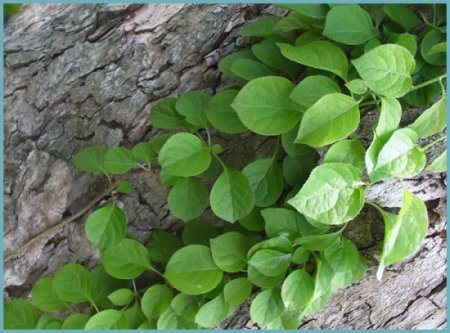

Another variety with round leaves received the corresponding name - round-leaved woodcutter. The leaves are large enough and can reach up to ten centimeters in length have a bright green color, which changes to fiery yellow in autumn.
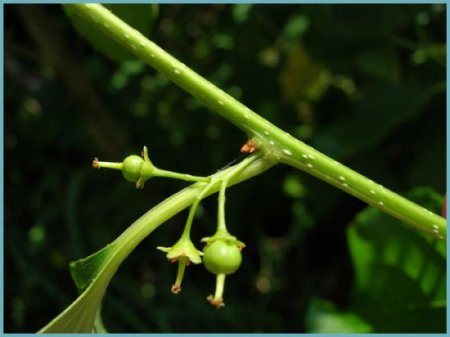

Small panicles with greenish flowers do not attract much attention, which cannot be said about orange bolls with bright red seedlings that can be seen when it cracks.
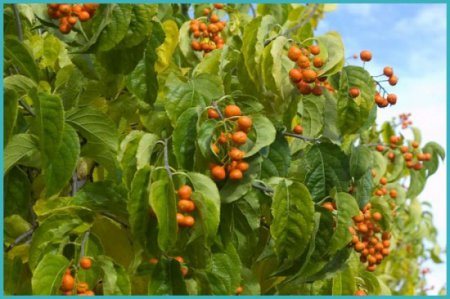

The most popular varieties include Diana, Hercules, and Scourge Lianas. The latter is often used as a ground cover for the decoration of gardens and parks in the northern regions.
Planting and leaving
If you want to start growing woodworm at home, you need to know about the basic requirements for planting a plant and caring for it. The first step is to decide on the place where the culture will be planted. As you know, it takes root well in spacious areas, in partial shade and in full shade. It is best to grow a vine near fences, gazebos and other structures that it will use as a support. As mentioned above, you cannot plant a plant near fruit trees and other ornamental plants, as this can lead to their death.
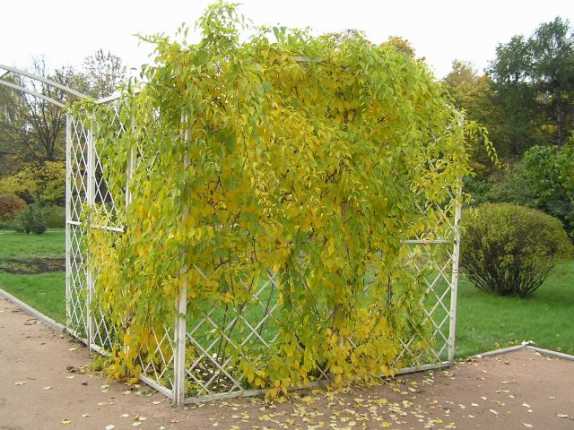

With regard to soil formulations, then in this regard the woodworm does not make high demands. It grows well on almost any soil, although the best development indicators are seen when using loose fertile loam and sandy loam soil with a neutral or slightly alkaline reaction. Before planting a crop in open ground, it must be fed with humus and leafy soil.
When planting seedlings, it is necessary to maintain a distance of about 1 meter between them. It is advisable to perform the procedure in early spring or autumn.The size of the planting pit should be up to 60 centimeters deep and 50 centimeters in diameter. The main layer of earth, which is located at the bottom, must be drainage. The root collar is slightly deepened, and immediately after planting, the trunk circle is mulched.
Adult plants are distinguished by good drought resistance, but young plants need three watering times in summer. At least 15-20 liters of water is poured under one bush, after which the near-stem zone is thoroughly loosened. When performing these works, it is important to remember about cleaning the soil from weeds, which often oppress the vine. Timely weed removal is the key to productive crop growth.
Woodworm cultivation, photo, varieties
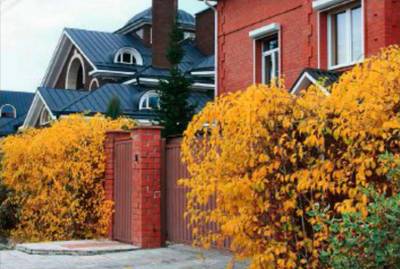

At the mention of these plants, many gardeners flinch and declare that they will never plant them in their garden. Like, they killed so many apple trees, and other trees got it. And the thing is that these tree-like vines are able to climb the trunks and crowns of trees to a great height, twisting them counterclockwise. Due to their rapid growth, they entwine the entire trunk of the host tree with their "strong embrace". At the same time, with special hooks, they not only cling to the bark, but also deeply pierce it, depriving the tree of life. As you can see, it is not without reason that these vines are called woodworms. Before my eyes, a 200-year-old oak tree in the arboretum almost died if the employees had not noticed the "aggressor" in time.
In fact, the woodworm is one of the most beautiful decorative lianas. The main thing is not to let the wind throw its top onto a useful plant, and even better - not to plant next to it. But if in your garden there is a dead tree trunk or a stone fence, then no doubt they can and should be decorated with wood-nose pliers.
About the plant
For decorative purposes, these vines have been cultivated since the 18th century. They are also called red bubblers for their brightly colored fruits: red, orange, yellow, especially spectacular in the fall against the background of yellowing foliage.
[k]
In addition, these plants are completely unpretentious, which has long been appreciated by knowledgeable gardeners. Wood-nose pliers do not suffer from high air temperature and dryness, they painlessly tolerate increased soil carbonate content, and multiply easily.
In nature, about 30 species are known, distributed mainly in the tropics and subtropics. In the Far East, 3 species grow: the wood-nose pliers are climbing, brush-shaped, round-leaved. In the middle lane, in addition to them, the North American climbing tree is cultivated.
Climbing wood plier, or lash-like with the help of sickle-shaped hooks, climbs up to a height of 10 m.In the State Botanical Garden, by the age of 14, the tree-nose liana grew to 2.5 m.The length of the rounded toothed leaves was 8 cm.They were light green in summer, they became yellow. In October, the leaves fell off. The flowers of the woodworm are yellowish-white, arranged in 1-3, open in the first half of June, last 9 days. The fruit is greenish-yellow, flattened capsule, filled with numerous seeds, ripening in early October. They are surrounded by reddish-brown seedlings, which often persist on plants until spring, decorating them in winter. The first flowering and fruiting of woodworms in Moscow was noted by us at the age of 8 years. Then it happened annually, often abundantly.
Recommended for you:
- Perennial vines, winter-hardy, names and photos
- Honeysuckle varieties, photos, honeysuckle honeysuckle, Tatar, ...
- Tulip tree - bell-shaped spatodea
- How to shelter climbing vines for the winter - clematis, ...
Brush-nose plier
In nature, the brush-nose plier can have a length of 10-12 m, and a trunk diameter of up to 6 cm.At 10 years, the liana reaches 5 m. It has large bright green leaves, wrinkled due to deeply depressed veins on the upper side of the leaf. The flowers are whitish, usually single. Blooms in the second half of June, 10-12 days. Fruiting annually from 10 years. Box fruits are bright yellow. The seeds are surrounded by red-orange seedlings.The fruits ripen by early October. This vine is considered one of the most beautiful. In addition, it easily tolerates the harsh winters of central Russia. At the end of September, the leaves turn light yellow or yellow. They fall off in October.
Round-leaved woodworm
The round-leaved woodworm in nature has a length of more than 12 m, in the Moscow region it does not exceed 8 m. cm, shiny above, below - glaucous. In summer they are green, in autumn they are bright yellow or orange. The flowers are small, inconspicuous, greenish, sitting in several pieces in bunches on short legs. Blooms in the second half of June for 2 weeks. Box fruits are original in shape and color: bright yellow or orange. The orange-red hemy is perhaps the most elegant. This plant blooms and bears fruit since 5 years. The seeds ripen in October.
He has a variety that differs from the species in a shorter length (at 14 years old, the length of the vine is 4.5 m), the leaves are smaller, there are white lenticels on the bark. Fruiting from 8 years old.
Climbing tree
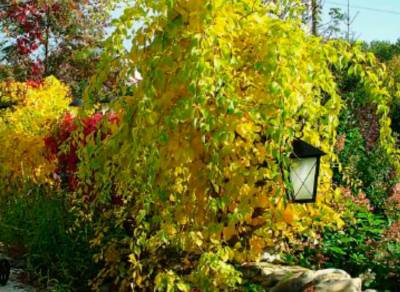

The tree-nose pliers climbing in nature has a length of 7 m, in Moscow at the age of 35 - 5.5 m. The shoots are naked, without thorns. Leaves up to 10 cm long. Flowers are collected in panicles - up to 10 cm long. They open in the first half of June after the unfolding of the leaves. Duration of flowering is 10-12 days. Fruits are roundish, yellow. It blooms and bears fruit from the age of 7. The seeds are surrounded by round, dark red seedlings, ripen in early October.
Growing and care
Growing woodworms in the garden is not difficult at all. They are light-loving and shade-tolerant.
Landing. Saplings take root well at the age of two to three years. Planting pit dimensions: 50x50x60 cm.When planting, a strong deepening of the root collar is not recommended, and the seedlings should be mulched with peat or sawdust with a layer of 5-7 cm.
It is advisable to leave the distance between plants about 1 m. Adult wood-nose pliers need high and powerful supports of 10-12 m, which are recommended to be placed immediately during planting. Plants can be planted and transplanted both in spring in April and in autumn in September.
When planting, the soil mixture should consist of humus, sod or leafy soil, taken in equal parts, with an optimal soil acidity of 6.0-7.0. Wood-nose pliers grow better on loose, fertile soils.
The plants are fed with Kemira Universal once in the spring: 100 g per 1 m2. Fertilizer is embedded in the soil and must be watered. During the season, three times watering is required from July to August, 15-20 liters of water for each adult plant. In drought, young seedlings are watered abundantly once a week. They loosen the soil near the plants simultaneously with weeding to a depth of 15 cm.
Pruning. In February, you can remove weak shoots by trimming the ends of the main branches. If necessary, thinning the crown and removing dried shoots is carried out. In summer, they are pruned more to remove growth activity. Wood-nose pliers are practically not affected by diseases and pests.
They hibernate without shelter. If, in severe winters, annual shoots of young plants freeze over, they quickly grow back. Mulching with peat in the first winter after planting keeps the roots from freezing.
Reproduction
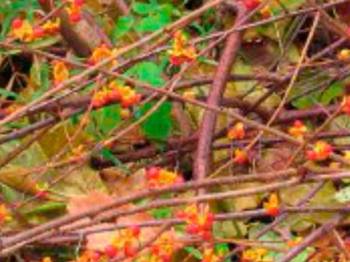

Most often, this is done with seeds, which are frozen for two months at a temperature of 2-5 ° C before sowing. Sown in the spring. When sown in May, seedlings appear in a month. You can sow in the fall, but only immediately after collecting the seeds, without drying, only clearing them from the seedlings. Planting depth - 1.5-2 cm. Seeds remain viable for 2-3 years. Summer or green cuttings of woodworm root well.
For example, in a brush-nose plier without the use of growth stimulants, 95-100% take root. For other types of wood-nose pliers, it is recommended to use Heteroauxin 0.01%. Processing time - up to 16 hours. Wood-nose pliers can be propagated by lignified cuttings, layering, root shoots. Cuttings are harvested in the fall.Circular trenches are dug near the mother bushes, the found roots are selected. They are stored in the winter in the basement in the sand and in the spring they are cut into cuttings 7-8 cm long and 5 cm thick. Then they are rooted in the beds, where shallow grooves are made. Sprinkle on top with humus or garden soil, watered. After two years of growing, the rooted seedlings are planted in a permanent place in the garden.
Using
It is not recommended to plant woodworms near fruit and valuable ornamental plants. Red bubble are suitable for decorating the walls of buildings and high stone fences, for vertical decoration of arbors, pergolas, trellis. As ground cover plants, they can be used to decorate slopes, river banks and streams. A dry branch with fruits without leaves can be a wonderful decoration for a winter bouquet.
How to care for a plant
In the summer, a young vine is demanding for regular watering, which should be done three times a day. Adult exactingness subsides a little and adult plants are already quite drought-resistant. Before the growing season, back in February, it is better to do sanitary pruning, removing frost-damaged shoots and forming the desired shape. Do not be afraid to cut long shoots, as a vine can grow up to one meter in a year.
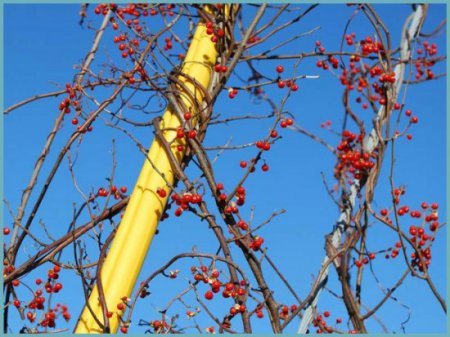

For the winter period, the plant is not covered, and if some shoots are frozen, they are simply cut off in the spring. For better growth, it is recommended to feed the plant with complex fertilizers in the spring and summer, after which the vine should be watered abundantly. In the autumn, fertilizers with potassium and phosphorus will be needed, which are applied to the soil to a depth of fifteen centimeters.
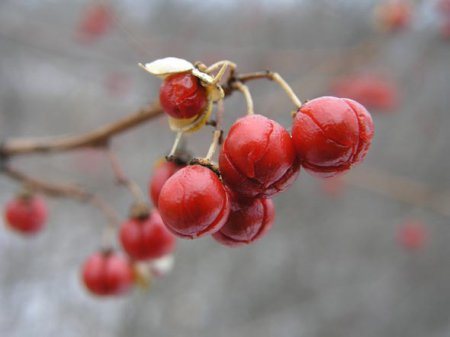

Some features of the woodworm
The woodworm plant is a dioecious species of lianas. In order for them to please the eye all year round, you need to acquire several seedlings, for example:
- 2 plants —
round-leaved wood plier Diana is a female species. - 1 plant - woodcutter Hercules - male tree.
Female species of lianas will delight in the fall with their beautiful fruits. Trees actively bear fruit only if there is a “male” nearby. After all, only she is able to pollinate female flowers. No fruit is formed on the male tree. It is clear that if only one female tree is present, then they will not have fruit. And vice versa, if you have purchased a round-leaved woodcutter Hercules, that is, a male-type liana, then you will not wait for colorful fruits. The male and female individuals of this plant must be present, then in the fall you will rejoice in the abundance of colors. Although if vines are used only for landscaping, then you should not bother about this. Just fruiting wood pliers are more decorative and look more spectacular.
Today the wood-nose plier is not very popular in our gardens, but its demand is gradually growing. It is advisable to purchase a plant from a nursery and avoid buying plants of unknown origin.
General information
It got its name for the property, which is detrimental to trees, to braid and strangle them in its arms. The tree dies, remaining an excellent support for the plant. For this reason, many gardeners do not risk planting a woodworm in their garden, fearing for trees, especially fruit trees. However, the growth rate of lianas, 1 m per year, gives them the opportunity to correct the direction of growth and support. In landscape design, the plant is used to beautifully weave houses and gazebos, as well as other suburban buildings.
Homeland of the plant
In Russia, in its natural habitat, the woody liana (round-leaved wood pliers) is found in the Primorsky Territory and on Sakhalin. The birthplace of the woodworm are:
- Equatorial and South Africa.
- Central America.
- Southeast Asia.
This type of lianas is most common in a narrow strip of the sea coast and in river valleys, as well as:
- In thinned forests.
- Thickets of bushes on sandy-pebble deposits.
- Rocky and rocky slopes.
Description of woodcutter
The woodworm is a deciduous vine growing at a high speed, often reaching 14 m. The shoots of the plant are green in color, gradually darken and crack with age.
Leaves are oval with a whole edge. At the beginning of the season, they are light green, then green, and by autumn they turn yellow and orange, creating a color for the decorated structure.
Gardeners and designers love the plant for its dense green mass of leaves, through which no light breaks through.
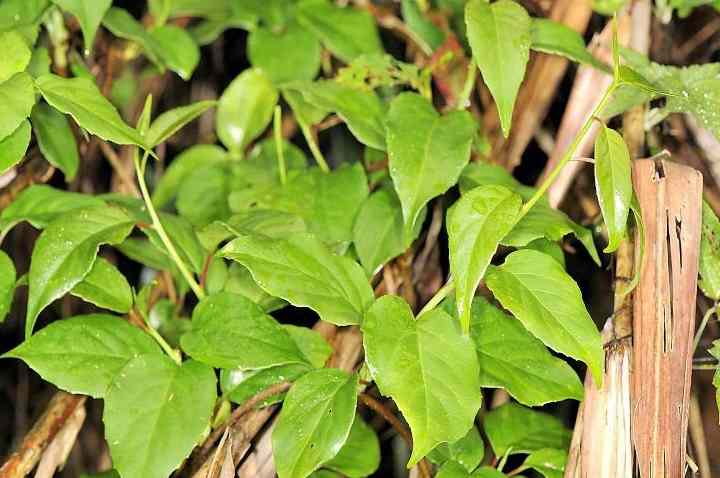

Interesting! All kinds of vines twine around obstacles counterclockwise,
Only with the first frost occurs, the woodworm completely sheds its foliage.
The first flowering of woodworm occurs no earlier than 5 years of age. The plant blooms in mid-summer with inconspicuous yellowish inflorescences with a pleasant aroma. Flowering lasts only 1 week. And at the end of summer, it forms seed pods, which reveal a red bubble, for which the plant has a second nickname - red bubble.
Reproduction of tree liana
The plant propagates both by seeds and cuttings. The seeds can be sown as soon as they ripen in the fall. Spring (April) is also a great time to plant the round-leaved woodworm. Growing a plant is as follows. Before spring planting, seeds are hardened for 2 months at a temperature of 2-5 degrees, or they are kept in wet sand for 30 days. Seedlings already begin to sprout in May, by autumn the seedlings will reach a height of about 80 cm.
The first 3 years are the most dangerous for young plants. To prevent them from freezing, the seedlings must be sheltered from severe frosts. For the first time, the woodworm blooms only at the age of 7 years. Vine cuttings are carried out in early spring. Semi-lignified shoots are suitable for cuttings. Cuttings 7 cm long are planted at an angle into the soil as a whole. After a month, the first shoots and roots appear. For the winter, young plants also need to be covered.
Saplings are grown in the nursery for 4 years, then they are sold. If there is a desire to buy a round-leaved wood plier, then it is best to choose a plant grown in a proven nursery. After 4 years, this plant will already bloom.
If the seedlings are planted in a row, then the distance between them should be about 1 meter. The soil is prepared as follows. Drainage is poured to the bottom of the pit - sand, crushed stone, caramzite. Then nutritious soil is poured.
Liana loves loose soil. Therefore, the ground under it must be loosened regularly. In the spring, the plant can be fertilized. In summer, in dry weather, the round-leaved woodworm requires abundant watering. When planting this plant, you must immediately take care of its support.
The woodworm can grow on any soil, also on dry soils. It will be better if the plant is planted in "poor" soil, as it grows very strongly on fertile lands. The arboreal vine also adapts well to acidic soil.
Reviews about wood pliers
Natalia Ivanova, 54 years old, Moscow
I have a small corner in my dacha where we like to gather with the whole family. Everything seems to be good, but the soul requires beauty. I thought for a long time to plant this, I was already going to plant grapes, but a neighbor advised a tree-nose plier. I immediately warned that if there are other trees nearby, they will die. I had nothing to be afraid of, since there is nothing on the site except greenhouses. She looked after the vines, although they said that this was not necessary. The plants grew very quickly, wrapped around all the supports, it looks great.
Nikolay Litvinov, 34 years old, Nizhny Novgorod
Recently my tree-nose pliers turned 10 years old, I'm not overjoyed in any way, I really like it. He braided the supports of the gazebo, the railings by the balcony with lianas. Most of all, I like how the vines creep along the trellis and wrap around it. In autumn, the site is filled with bright colors from foliage. Unfortunately, I haven't seen the fruits yet, but I don't lose hope, maybe it's just that the time has not come.
Application in garden landscaping
Liana woodworm is a wonderful addition to the garden.Its crown will beautifully complement the garden area, hide an unattractive fence. In this case, it will be necessary to vertically direct the culture.
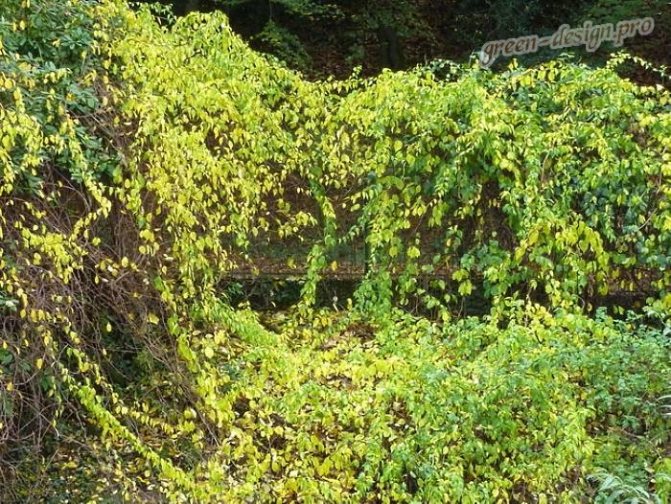

Woodlip in the garden
Also, the plant is often planted as a ground cover, which allows you to decorate different slopes, shores of home reservoirs. In a flower bed, the liana will become an excellent backdrop for plants with multi-colored flowering.
Red bubble is the perfect choice for decorating rocky fences.
Using the pliers in landscape design
Recently, this culture has become quite common in the design of a particular site or object. With a plant that has the shape of a vine, you can beautifully decorate a gazebo, a building wall or an arch. Before planting a woodworm, you need to carefully study all the points on planting and caring for this plant. There are a variety of varieties that can meet different design requirements for decoration. There are varieties that resemble ground covers in their shape, they, as a rule, grow with a fairly dense carpet. The tree-nose, which has a climbing shape, lands on the hilly banks near the reservoir. This plant is perfectly capable of giving a decorative shape to such a site.


The greatest demand among landscape designers is the climbing tree. It is often planted to decorate various plots of land. Even if you give this plant a minimum of attention, then further growth will still be quite active, thereby landscaping the supports and buildings occurs quite quickly.
Planting technology of woodworm
The redbubble belongs to unpretentious plants.
It grows in a variety of soils, garden soil works best.
All parts of the plant are poisonous to humans; hands should be washed after work.
It should be explained to children that bright fruits are inedible and dangerous.
Choosing a landing site
Liana grows more intensively in open areas. Shaded areas will affect both the growth rate and the color of the foliage.
It is advisable to plant the tree-nose pliers near the gazebos or fence.
In open spaces, a strong support is erected for the seedling.
The soil
The best option would be fertile, slightly acidic or neutral soil.
Compost is added to the pits before planting. The root system does not need drainage.
Time
Two-year-old seedlings take root well both in spring and autumn. At the beginning of the season, work is carried out before bud break.
In the fall, you need to have time to plant the plants before the onset of severe frosts.
How to plant
The depth of the planting hole should be slightly deeper than the root system itself.
Its width is 50 cm. The roots are carefully buried, leaving the root collar above the surface.
When planting in groups, the distance between plants is 1 m.
Main varieties
There are many varieties of this exotic liana in the world. One of the most common is the Diana climbing plier, the planting of which and caring for it will be discussed below. Under natural conditions, the plant can grow up to seven meters in height with strong, mature shoots. Petiole leaves are characterized by a pointed shape at the top and rounded at the bottom.
In the summer, they get light green shades, and in the autumn - yellow, after which they begin to fall off. The yellow and white branches are of no decorative value and begin to bloom in June.
The main "highlight" of the appearance of the woodworm are its colorful fruits, which are represented by small yellow capsules. With the advent of winter cold, these boxes continue to hang on the tree, decorating it in every possible way.
And also the round-leaved species is in special demand. Its height can reach 12 meters, although this is not the case with domestic cultivation, which is explained by trimming. The round-leaved woodworm has a very lush crown and creeping stems of large diameter. Mature stems are covered with a rough brown bark with a cracking surface.
As for the leaf plates, they have an ovoid and pointed shape. Their size reaches 10 centimeters. In summer, the leaves are painted in a glossy dark green shade, and in autumn they take on a bright yellow color. Greenish flowers form scutes.
Among the most popular varieties that are used for home cultivation, it should be noted:
- The round-leaved tree plier Diana is an ornamental variety of the female plant, which is distinguished by abundant fruiting and incredibly beautiful appearance. The disadvantages include the need to carry out seasonal pollination.
- Hercules is a representative of the male infertile form, which performs a decorative role and is used for landscaping areas.
- Scourge-shaped wood plier - belongs to the group of decorative lianas, the height of which reaches 10 meters. Mature stems are reddish brown, while newly growing stems are green. The leaves are ovoid and have a light green tint. Small flowers are yellowish and form a scutellum of 1-3 specimens. At the initial stage of development, the fruits acquire a greenish tone, and as they ripen, they become bright orange. The crop can be grown in cold regions as it demonstrates good frost resistance.
Growing syngonium in the house: planting and caring for an indoor flower
Woodlip - ornamental vine
There are two types of shoots in the woodworm. Some are curly, short, with few leaves, others are straight, with rather dense foliage. Leaves are simple, alternate. Flowers are small, dim, sometimes solitary, sometimes gather in panicles. The fruit looks like a box in the shape of a ball, opens with three valves. Around the seeds is a fleshy seed-plant.
The woodworm is an unpretentious plant, does not require special soil, grows well in the shade, although it loves illuminated places.
Plant species
The woodworm is resistant to various diseases and is practically not attacked by pests.
Several types are grown:
- Brush-shaped.
- Round-leaved. Seeds of this species (for example, such as the round-leaved woodcutter Monarch) can be ordered on specialized sites.
- Braided.
- Climbing.
- Curly.
- Tenacious.
In Russia, only 2 types of frost-resistant tree liana are widespread - these are tenacious and round-leaved. Outwardly, these two species are almost the same.

